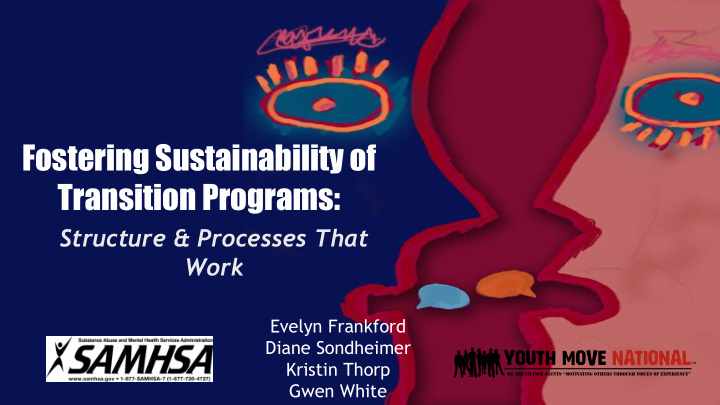



Fostering Sustainability of Transition Programs: Structure & Processes That Work Evelyn Frankford Diane Sondheimer Kristin Thorp Gwen White
Importance of Sustainability Sustainability is the continued use of program components and activities for the continued achievement of desirable program and population outcomes Scheirer, M.A., & Dearing, J.W. (2011). An Agenda for Research on the Sustainability of Public Health Programs. American Journal of Public Health, 101 (11).
Methodology ▪ Methodology: • Semi-structured interviews with three jurisdictions: • Vermont • Georgia • Allegheny County (Pennsylvania) • Themes based on SAMHSA Theory of Change covering five key areas
Inquiry Findings: Leadership, Management, and Oversight ▪ Capacity building • Enhance interagency relationships ▪ Infrastructure development ▪ Policy change ▪ Workforce development • Emphasis on including young adults in the workforce • Peer Supports • Youth Coordinators
Inquiry Findings: Policies and Procedures ▪ Essential for long-lasting impact ▪ Improved communication between systems ▪ Workforce development • Standards and requirements built into contract language ▪ Individualized policy changes within agencies
Inquiry Findings: Financing ▪ Build on previous and existing grants ▪ Adjust state or county general fund dollars • Capitalize on block grant dollars ▪ Partner with Medicaid Authority ▪ Maximize evaluation data • Policy advocacy tool • Decision-making tool
Inquiry Findings: Services and Supports ▪ Adaptation of services or use of treatment models for young adult population • High Fidelity Wraparound • Transition to Independence Process (TIP) • Modification of CANS • Youth Thrive ▪ Build proactive system of supports • Low barrier drop-in centers • Youth peer support
Inquiry: Youth-Driven Practice ▪ Include youth in governance structures ▪ Offer leadership development ▪ Provide life skills and education opportunities ▪ Build workforce capacity • Include young adults in the workforce ▪ Partner with existing youth programs and organizations
Challenge: Bridge to Adult System ▪ Each jurisdiction expanded scope of child system but had limited success in changing access to adult system • Restrictive eligibility criteria • Serious Emotional Disturbance vs. Serious Mental Illness ▪ Overarching challenge: • Creating bridge between child and adult systems • Overcoming limited services & supports for this population
Key Features of Successful Initiatives ▪ Adapt to pre-existing infrastructure, culture & political climate ▪ Prioritize policy and procedural change ▪ Build youth-driven systems ▪ Find champions with commitment
Key Features of Successful Initiatives • Engage youth in a strength-based way • Emphasize youth leadership and decision- making • Support youth and young adults to pursue education and employment
Discussion
Contact Us! ▪ Evelyn Frankford: evelyn.frankford@gmail.com or (617) 388-0616 ▪ Diane Sondheimer: diane.sondheimer@samhsa.hhs.gov or (240) 276-1922 ▪ Kristin Thorp: kthorp@youthmovenational.org or (202) 559-1528 ▪ Gwen White: gwhite@greatlakesresearch.com or (724) 816-9262
Recommend
More recommend